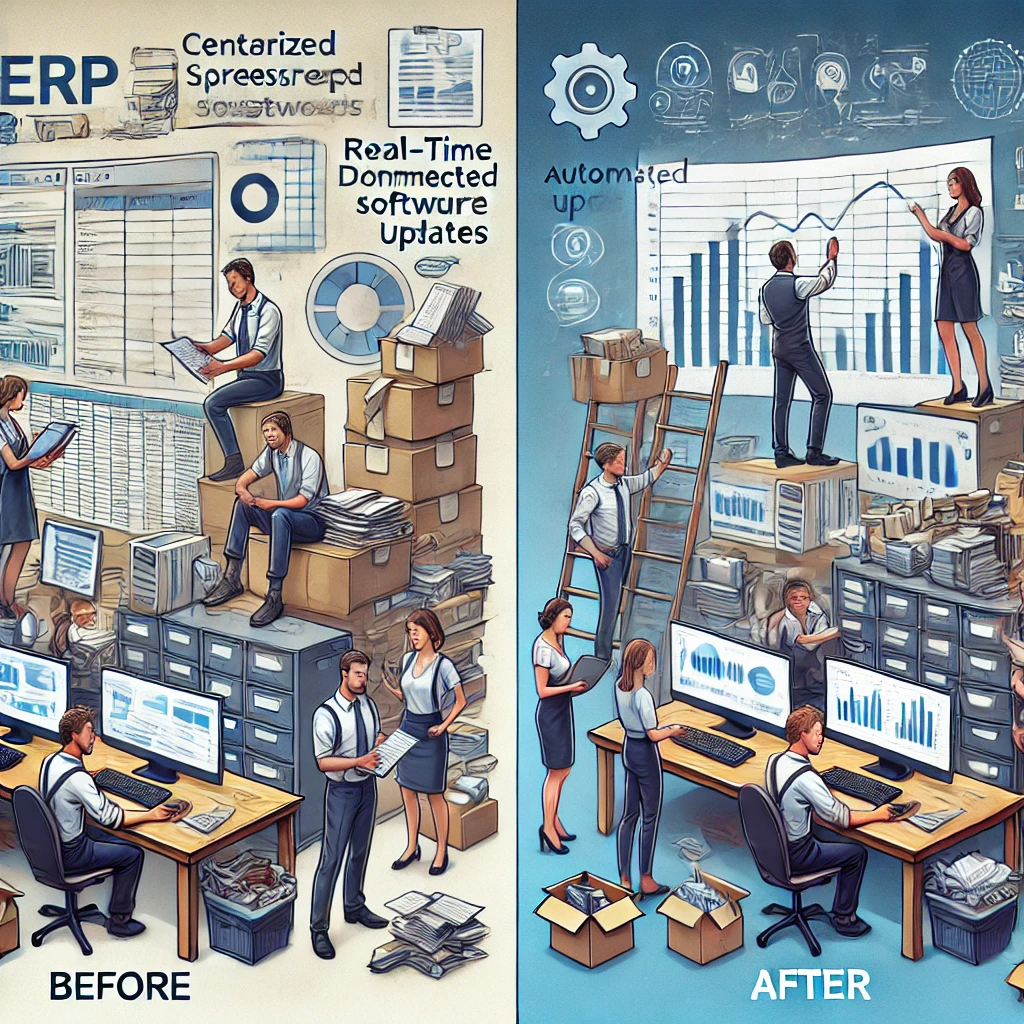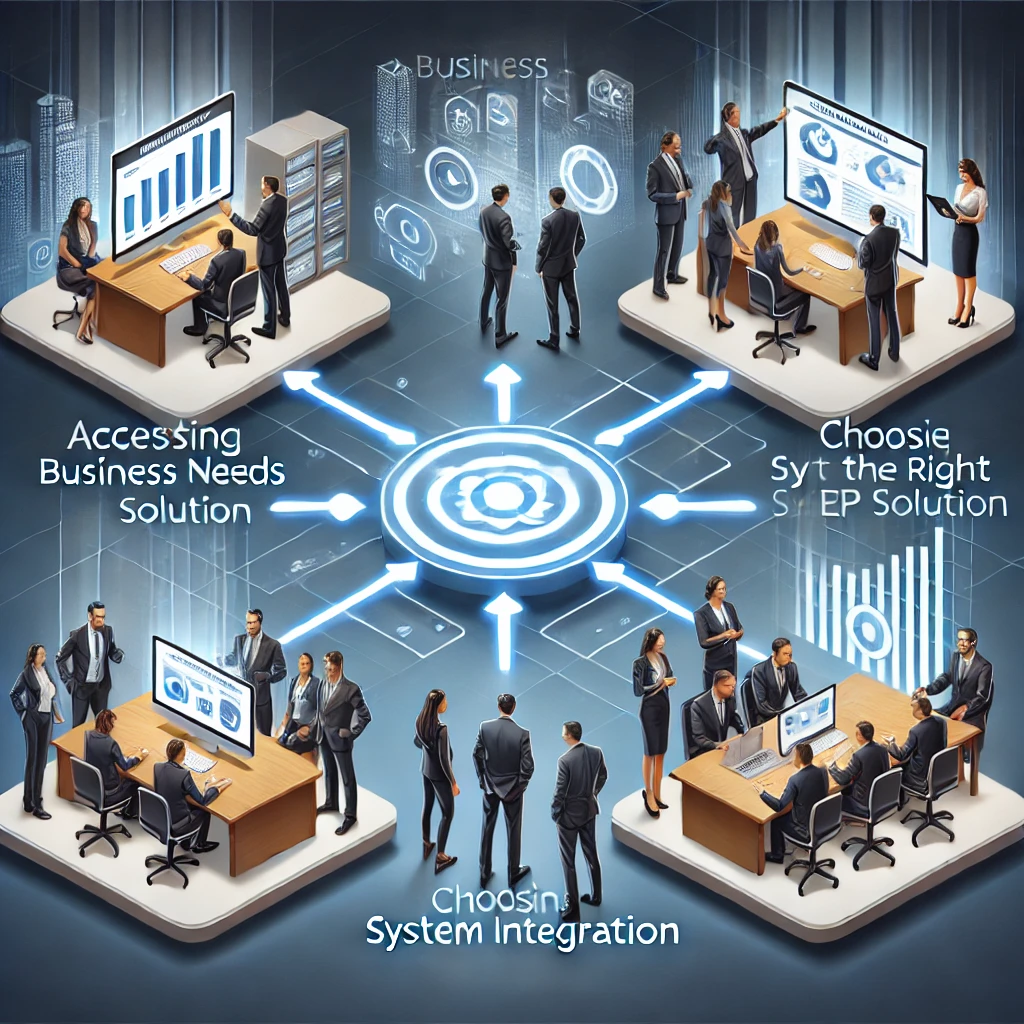Introduction: Smart Business, One System!
Running a business is challenging—you have invoices to track, employees to manage, sales to monitor, and customers to keep satisfied. Many startups and entrepreneurs struggle with managing different aspects of their business across multiple disconnected platforms. If you are still relying on spreadsheets, emails, and various unintegrated applications, it is time for a change.
In this guide, we explore Centralized Business Management Tools, specifically Custom ERP solutions, and how they can transform your business into a streamlined, automated, and highly efficient operation. If you have ever felt overwhelmed by disorganized workflows and inefficient processes, this article is for you.

Identifying the Chaos in Business Operations
Many businesses face operational inefficiencies due to a lack of integration. Here are the common challenges startups and entrepreneurs encounter:
- Multiple software for finance, HR, inventory, CRM, and sales, making it difficult to manage everything in one place.
- Employees spending excessive time manually updating spreadsheets and reconciling data.
- Generating reports feels like detective work because data is scattered across multiple platforms.
- Decision-making is slow due to outdated or incomplete information.
- Disconnected teams where customer service, sales, and HR do not have real-time access to crucial business insights.
If you can relate to these issues, do not worry—there is a better way to manage your business.
The Power of Centralized Business Management Tools
A Custom Enterprise Resource Planning (ERP) system integrates all business functions—finance, HR, inventory, sales, customer management, and operations—into a single platform. This means that instead of juggling between multiple apps, you have one system that acts as the central brain of your business.
Why is a Centralized System a Game Changer?
- Eliminates the need for multiple tools – Everything you need is within one system.
- Provides real-time data access – No more relying on outdated reports.
- Generates reports in seconds – Fast, accurate, and automated insights.
- Automates manual tasks – Saves time and increases efficiency.
- Ensures scalability – Whether you are a startup or an enterprise, the system adapts to your growth.
How Centralized Business Management Works
A well-implemented ERP system simplifies business operations in several ways:
- Unified Business Dashboard – All aspects of your business, from sales to HR to inventory, are managed from a single platform.
- Automated Workflows – Routine processes like payroll, order processing, and financial reporting become automated, reducing manual effort.
- Enhanced Collaboration – Sales teams can access real-time inventory updates, customer support can see order history, and HR can track performance within one system.
- Instant Analytics and Reporting – Need financial reports, inventory trends, or customer insights? Get accurate data in just a few clicks.
- Scalability for Growth – The system grows with your business, ensuring long-term sustainability.
Real-Life Example: A Startup’s Digital Transformation
Case Study: Retail Startup
Consider a retail startup struggling to manage its operations. Before implementing a centralized system, the business used:
- Excel sheets for inventory management.
- A separate tool for invoices and billing.
- WhatsApp groups for internal team communication.
- A standalone CRM for customer data.
- Another software for payroll processing.
The lack of integration led to inefficiencies, errors, and wasted time. Employees had to manually transfer data between different tools, which increased the risk of human errors. There were frequent stock discrepancies, delayed payments, and a lack of coordination between departments. Sales teams often sold products that were out of stock because inventory updates weren’t in sync with sales data. Additionally, payroll processing required hours of manual effort every month, leading to frustration among employees and management.
After implementing a Custom ERP system, the startup experienced:
- Automatic stock updates whenever a sale was made, reducing errors and improving inventory accuracy.
- Real-time invoice tracking with automated payment reminders, ensuring better cash flow management.
- Seamless team communication, with all teams having access to shared, updated business data.
- Automated payroll processing, cutting down manual effort and reducing payroll errors.
- Instant access to sales trends, allowing the company to make better strategic decisions for expansion.
Case Study: Tech Startup
A growing tech startup providing SaaS solutions faced similar challenges. The company was handling:
- Multiple platforms for customer support and subscription management.
- A CRM disconnected from its invoicing system.
- HR software that didn’t sync with payroll and attendance tracking.
- A lack of real-time analytics, making financial forecasting difficult.
By integrating a centralized ERP, the startup gained:
- A unified platform where all customer, sales, and finance data were linked.
- Automated customer invoicing directly tied to subscription renewals.
- Seamless payroll and HR integration, reducing payroll errors and compliance risks.
- Advanced analytics and real-time reporting, allowing better business decision-making.

Why Startups and Entrepreneurs Should Care
Inefficiencies in business operations translate into financial losses. Here is how centralized business management tools can save both time and money:
- Time Efficiency – Automating repetitive tasks allows your team to focus on strategic growth initiatives instead of administrative work.
- Cost Savings – Reducing reliance on multiple software subscriptions lowers operational expenses.
- Data-Driven Decisions – Real-time insights help businesses anticipate risks, optimize inventory, and improve financial planning.
- Scalability – The system adjusts to growing business needs, making expansion seamless.
How KSoft Technologies Empowers Businesses with Custom Solutions
At KSoft Technologies, we specialize in providing comprehensive digital solutions that help businesses navigate the modern digital landscape with ease. Our approach focuses on empowering businesses with automation, intelligent insights, and seamless integration to enhance efficiency and scalability.
Our Expertise in Business Automation and Digital Solutions:
- Web Development – Crafting high-performing, SEO-optimized websites that drive engagement and conversions.
- Mobile App Development – Creating feature-rich, intuitive Android & iOS applications tailored for business growth.
- Custom ERP Solutions – Designing intelligent automation to optimize workflows, enhance productivity, and streamline operations.
- Ongoing Maintenance & Support – Ensuring continuous monitoring, updates, and performance enhancements to keep systems running smoothly.
- AI-Driven Process Automation – Automating repetitive tasks to improve efficiency and eliminate bottlenecks.
How We Help Startups and Entrepreneurs
- Tailored Digital Transformation – We analyze your business needs and design solutions that align with your unique requirements.
- Seamless System Integration – Our solutions ensure smooth transitions, eliminating operational silos and increasing overall efficiency.
- User-Friendly and Scalable Platforms – We create intuitive and adaptable systems that grow alongside your business.
- Strategic Insights and Reporting – Gain access to real-time data and analytics for better decision-making.
- Dedicated Support and Consultation – Our expert team provides round-the-clock support to ensure seamless operation.
Why Startups and Entrepreneurs Should Care
Inefficiencies in business operations translate into financial losses. Here is how centralized business management tools can save both time and money:
- Time Efficiency – Automating repetitive tasks allows your team to focus on strategic growth initiatives instead of administrative work.
- Cost Savings – Reducing reliance on multiple software subscriptions lowers operational expenses.
- Data-Driven Decisions – Real-time insights help businesses anticipate risks, optimize inventory, and improve financial planning.
- Scalability – The system adjusts to growing business needs, making expansion seamless.
Steps to Implement a Centralized Business Management System
Step 1: Assess Business Needs
Identify the most pressing operational challenges in your business. Is it inventory management, customer tracking, payroll, or data reporting?
Step 2: Choose the Right Solution
Partner with an experienced provider like KSoft Technologies to develop a solution tailored to your business model.
Step 3: System Integration and Employee Training
Ensure a smooth transition by integrating the new system with existing operations and providing staff with adequate training.
Step 4: Automate Workflows and Monitor Performance
Leverage automation for repetitive tasks and continuously optimize the system based on real-time performance data.

Final Thoughts: The Future of Business Management
If your business is still operating with outdated manual processes, you are likely missing out on opportunities to save time, cut costs, and enhance efficiency. A Centralized Business Management System is not just an upgrade—it is an essential tool for modern businesses to scale effectively.
At KSoft Technologies, we empower startups and entrepreneurs with custom business solutions designed for efficiency, automation, and data-driven decision-making.
Ready to Transform Your Business?
We offer free consultations to help you assess your needs and implement the right solution for your business. Contact us today and let’s make your business work smarter, not harder.
📩 Contact KSoft Technologies Now!



